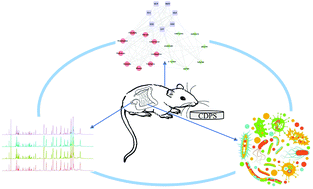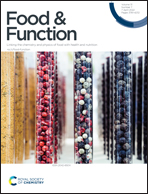Microbiome-metabolomics deciphers the effects of Cistanche deserticola polysaccharides on aged constipated rats†
Abstract
Chronic constipation is an extremely common gastrointestinal disorder that severely affects the life quality of the elderly. As an edible food and therapeutic medicine, Cistanche deserticola (CD) has been widely used not only as food in daily life, but also as a medicine to treat constipation. As the main component in CD, polysaccharide shows great potentials in improving constipation in the elderly. In this study, 16S rRNA analysis and fecal metabolomics were applied to investigate the impacts of constipation in an aged rat model, as well as the regulatory effects and the underlying mechanisms of CD polysaccharide (CDPS). Firstly, a classic constipation model of aged rats was constructed. The behavioral indicators of the rats were analyzed, providing behavioral correlations at the macro level. Meanwhile, the levels of SOD, GSH-Px, MDA, and CAT in serum samples of the rats were assessed. Additionally, the changes of gut microbiota, fecal metabolites and corresponding metabolic pathways in the aged constipated rats were demonstrated. On top of this, inter-and inner-layer networks of “behavioral indicators – intestinal bacteria – metabolites” were constructed to visually demonstrate the relationships among differential indicators. We found that CDPS significantly regulated the abnormalities of the behavioral indexes, the microbial richness and diversity, and the metabolite profiles that were induced by constipation in the aged rats. From the intestinal microbiological point of view, CDPS significantly increased the prevalence of beneficial bacteria while reducing the potentially pathogenic bacterial population. In terms of metabolomics, a total of 16 metabolites were finally identified as potential biomarkers of constipation in the aged rats. The mechanisms of CDPS were mainly involved in metabolic energy and the synthesis of amino acids. The current findings not only deepen our understanding about constipation in the elderly from the perspectives of microbiome and metabolomics, but also lay a solid foundation for the applications of polysaccharides in constipation in the elderly, the discovery of new medicines for constipation, and improving the life quality of the elderly.



 Please wait while we load your content...
Please wait while we load your content...